When I raise chicks, I find that they quickly out grow the space and need more stimulation than the four walls of the brooder box. Yet they are not ready to live in the coop with the adult chickens, who will terrorize the youngsters at best, and possibly kill them. So we put together this simple, movable baby chick playground with materials we had left over from other projects, and furnished it with food water, a nest box, logs, and branches. We put the chicks in it during sufficiently warm weather, and return them to the brooder for the night.
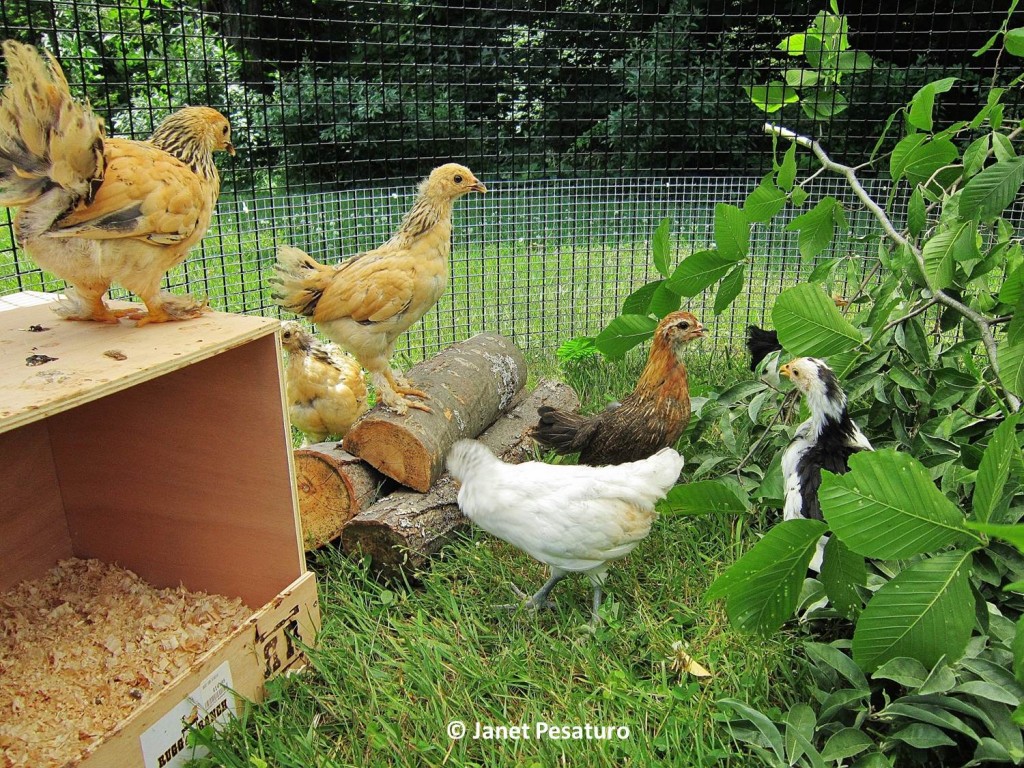
These young bantams enjoy perching on and flying from the logs and nest box in their baby chick playground.
Materials for baby chick playground
- A 20 ft long and 4 ft high piece of PVC coated hardware cloth, wrapped in a roughly 6 ft diameter circle
- Large, black metal paper clips hold it closed.
- The lower portion is reinforced with a 1 ft high length of 1/2 inch hardware cloth, so young bantam chicks cannot squeeze through the 1 inch openings of the PVC coated fencing.
- The “roof” is a piece of ripstop nylon, fastened to the fencing with large black paper clips.
Of course you can fashion your own playground using whatever you have on hand, but here are some general considerations:
Food and Water
Be sure to keep fresh water and chick feed in the playground, as baby chicks need these at all times. They will not be able to find enough wild forage even in this outdoor playpen. In the wild, the mother would be free to lead them to good sources of food, and she would show them what to eat.
Safety
Ours is not meant to be predator proof, so we use it only when we’re home and able to keep an eye on it. It’s neither safe enough nor warm enough to house the chicks at night, so they come back into the brooder box for the night. If you want something safe enough to house them for the day while you go off to work, you will need something much sturdier. Also, be sure there are no sharp edges, because a cut on the foot could lead to bumblefoot. We sanded the sharp edges of the nest box.
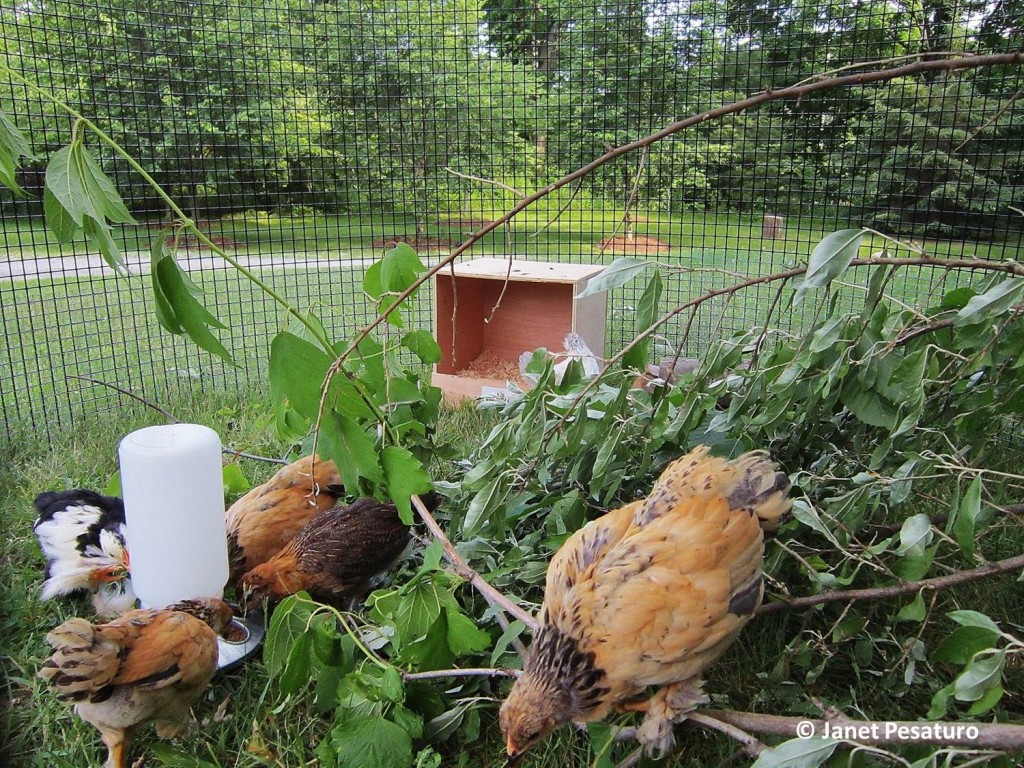
Plenty of stimulation that allows chicks to express their natural instincts helps prevent behavior problems, like feather picking. Here, a bantam brahma perches on a branch and examines the vegetation.
Stimulation
The wild relatives of the domestic chicken range over many acres within tropical forest or shrubland, comprised of a wide diversity of vegetation and insect prey. They are active, busy animals by nature, so it’s no surprise that domestic chickens in barren confinement become bored to the point of cannibalism (feather picking, toe picking). Studies show that providing appropriate stimulation prevents it, as you can read here. This is how I provide stimulation in the playground for the chicks:
- Logs for perching and flight practice.
- A nestbox for shelter (they snuggle in it if they get chilly) and also for perching and flight practice.
- Branches of at least 3 species of trees or shrubs, for foraging, shelter, and shade. Different plant species carry different insects, so this ensures that they have not only interesting vegetation to explore, but also a variety insects to forage. I use any and all shrub or tree species, except for thorny ones, which could cut their feet. Each day, I replace the old ones with fresh ones.
- Fresh grass daily. The playground is easy to disassemble and move, so it’s moved every day.
Younger chicks need more warmth and sleep, so at first I might leave them in the playground for only an hour or two. As they grow, they want more stimulation and enjoy longer play sessions. I’ve noticed that upon return to the brooder box, they are hungry and exhausted. A feast is followed by a nice long nap. And nobody picks feathers or toes.
How do you provide stimulation for growing chicks? Please feel free to share your ideas, and to ask questions in the comment section below!
Shared on: Homesteaders Hop #6, Simple Life Sunday #11, Homestead Barn Hop #153, Natural Living Monday, Tuesdays with a Twist #52, Backyard Farming Connection #74, Wildcrafting Wednesday #131, Down Home blog Hop #82, HomeAcre Hop #64, From the Farm blog hop, Simply Natural Saturdays, Mostly Homemade Mondays #75, Thank Goodness it’s Monday #66











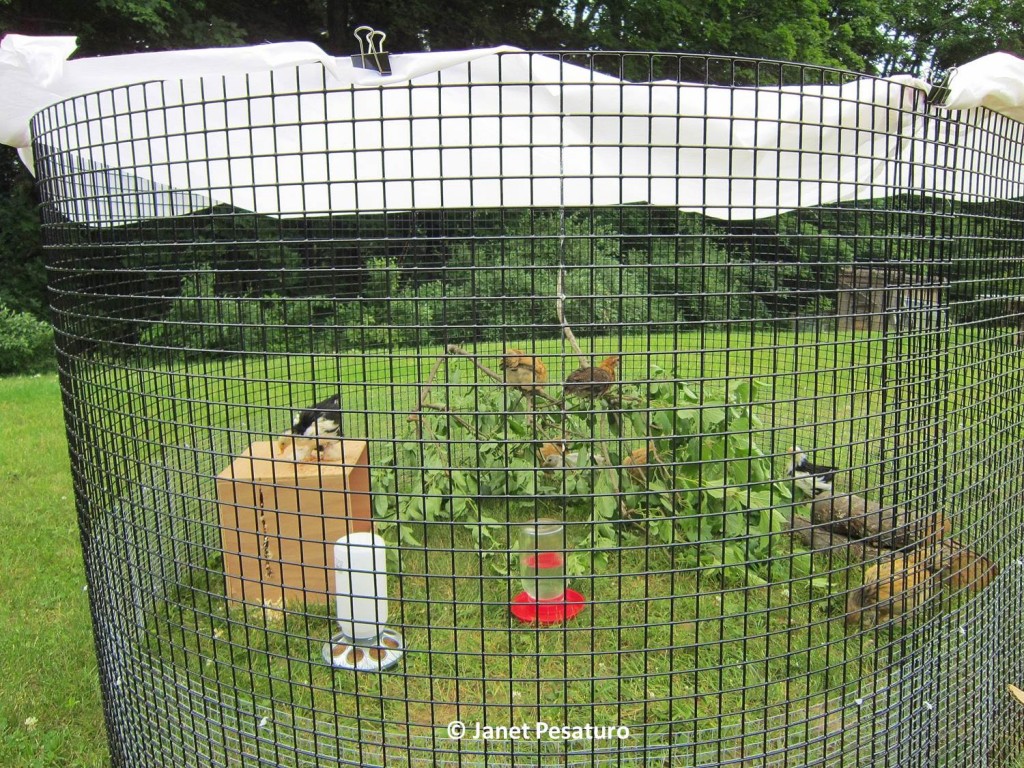
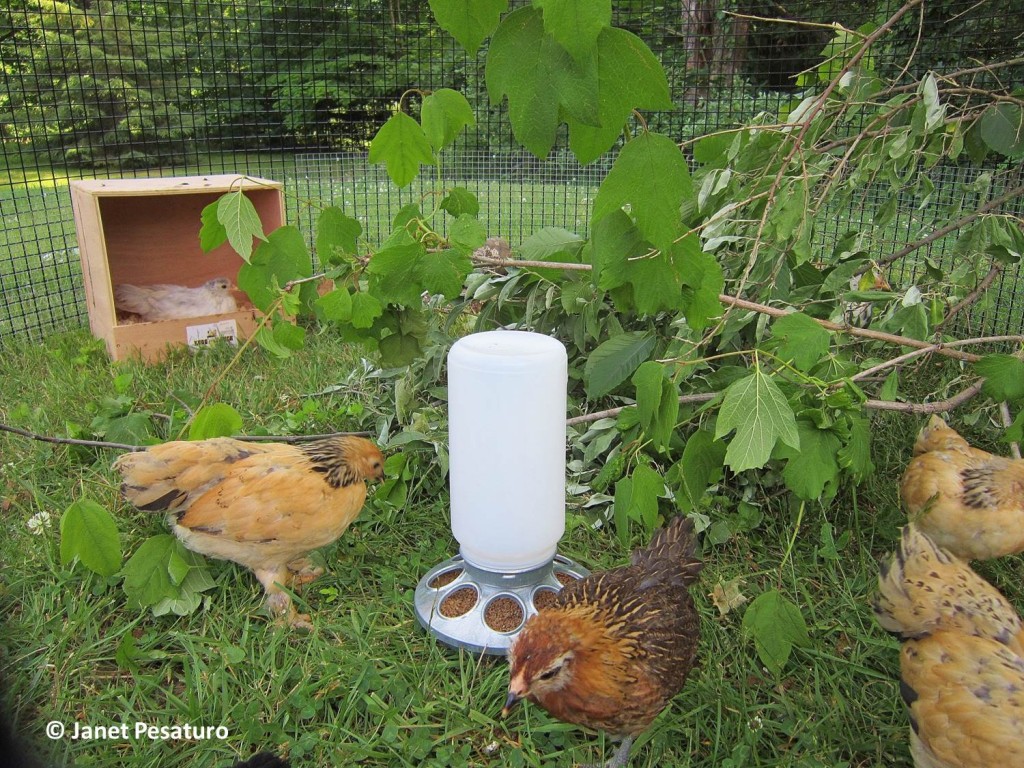
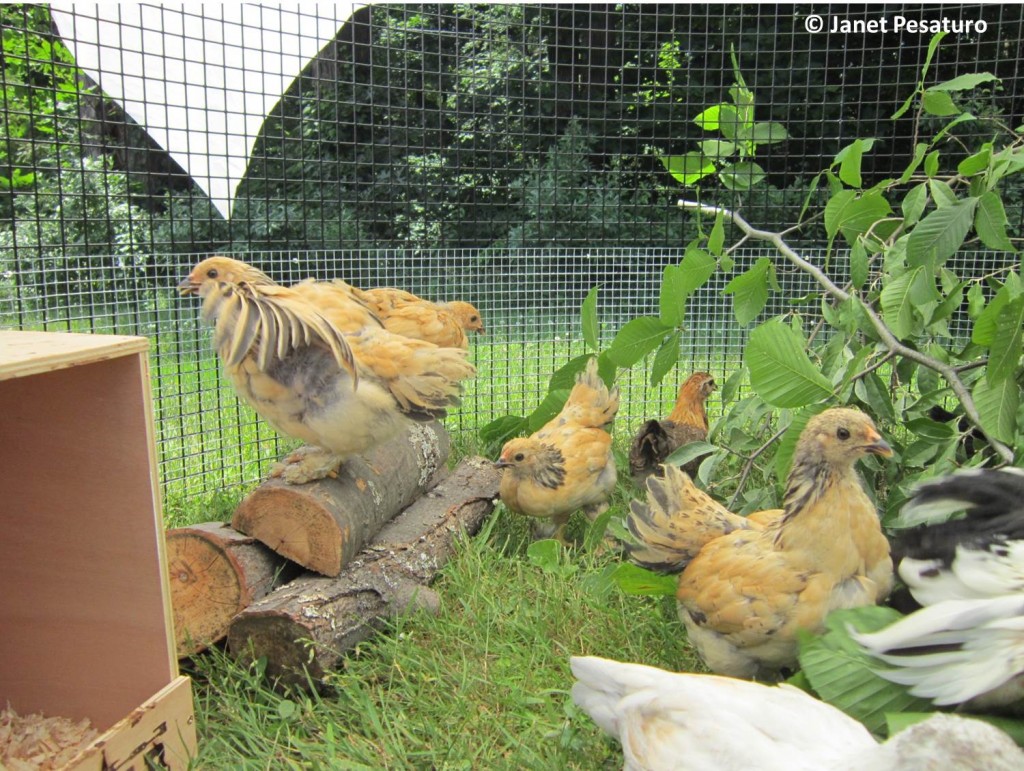
This is a great idea — might try it next year if we buy chicks again. We usually let momma birds hatch and raise their own chicks, but we got 6 this year from the feed store to diversify the flock. They quickly outgrew the large plastic bin we’ve had them in, but the temps have just been too cold this year to put them out. We have a large chicken coop that we’ve portioned off a protected area. We put our growing chicks in there for a few weeks before letting them loose with the other chickens. We’ve found that the chickens become more acclimated to the newcomers when they can see and hear them but cannot get to them.
Yes, good point, the adults do become accustomed to the newbies more quickly if they can see and hear them. So sometimes I set up the playground within our adult chicken yard.
I do the same. I also toss scratch feed on the ground at the adjoining wall. They actually peck and eat face to face- young anf older- for a while before opening the door to join the rest of my flock.
Love this post. Just bought 8 baby chicks today and will definitely be modeling a playpen for them after yours. Thank you for the great ideas.
Great! I’m so glad it was helpful!
I love that black and white chicken … although they are all cute! I never thought about having branches in their play area. Great idea!
I never thought about having branches in their play area. Great idea!
Thanks! The black and white chick is a mottled cochin, by the way.
Thanks for the info. I haven’t seen that breed before. By the way, do you know what the light brown birds are? We received one of those last year (free) … but we don’t know what it is.
You mean the chunky buff ones? Those are bantam buff brahmas. The medium brown one is an easter egger, but there are lots of breeds with that coloring when young.
I’ve done something similar, but we haven’t any vegetation leafed out yet. I’ve pulled clumps of native grasses with root bundle for them and they appear to enjoy scratching and pecking into it. They also get loads of jumping and wing flapping activities with boxes. So, I will add a log or two for the play area as well. This is a very useful article, thank you.
Cheers,
izzi~avis
Oh, I love the root bundle idea! Brilliant!!
Love your chicken playground. We did something similar when our girls were young and they loved being outside. It gave the cats a chance to get used to them while they were protected!
Thanks. Yeah, it helps a little to get the cats used to them while they’re protected, but our cats seem to see them as prey until they reach adult size.
Pingback: Simply Natural Saturdays 4/05/2014 - Crunchy Livin Mama Style
Pingback: Raising Chickens: An Introduction - Survival at Home
So many great ideas in this piece. Thank you for sharing. The one other thing I did this year with my baby chicks is “raid” my compost bin that was full of red worms. I dug up a couple of chunks of soil (filed with the squirmy worms) and plopped them down in the area they were free ranging in. They had a ball scratching and pecking the wiggling worms and enjoyed a great protein snack at the same time.
Oh yes, they love worms, Donna. Mine get all excited and follow me when they see me carrying a shovel, because they’ve learned that digging means worms for them!
I’ve recently retired and purchased 2 acres in NC where I am building a Log Home and intend to have a 1/2 acre farm just as you described on your acre. Of course I will have chickens and am so inspired by your blog and the responses of your readers. I am in the planning stages right now and reading everything I can to be a good “chicken mom”. I hope to keep in touch. Thanks for sharing your information. It is appreciated.
Oh wow, a log home sounds delightful. Good luck with your new farm!
I think this is a great idea, but where we live it is still cold right now, hopefully it warms up soon. At what age did you start putting your chicks in the play pin? I have so that are about a week old and they try to fly and they scratch at the floor of the brooder all the time.
Hi Natalie, if it is warm enough, I begin giving them a brief “recess” in the play pen at just a few days old. I watch them carefully when very young, to be sure they don’t get too cold. I might give them only an hour, but when/if they seem happy and warm, I let them stay longer. By the time they are a few weeks old, they spend much of the day in the play pen, weather permitting. I live in Massachusetts so I never get chicks before late April (usually I wait till May), so it will soon be warm enough to give them significant time outdoors in the pen. Hope that helps!
This is BRILLIANT! I now have an after work project for this week. I’m thinking my only tweak will be to get a small plastic kiddie pool, anchor the hardware cloth to it. Turn it upside down so the pool is the roof and stake the hardware cloth in the grass-with easy to remove but sturdy stakes. My month old chicks need more space and this is just the answer I needed! This will help my hens (and cat) get used to them without any drama. Thank you for sharing!!! -TxChickenMama
Glad it was useful to you, Melissa! Good luck with your flock.
How warm is warm enough. I live in Oklahoma. And my chicks are about 3 weeks old. I know they would love the playground but this is the first time for me to raise chicks and I don’t want them to get to cold.
Hi Cheryl, read sections 6 and 7 in the following post on raising baby chicks without a hen, for a discussion on temperature for chicks as they grow, and putting them outside: https://ouroneacrefarm.com/raising-baby-chicks-without-a-hen-the-first-6-weeks/
Hi! I know that this is an old thread, but I just have to say, I really like this idea! Would like to add, though, that in places where there are lots of windy days, it would probably be a good idea to use either cheap tent stakes, or the staples they use of putting weed barrier down when they landscape. This would blow away like a kite in North Dakota! Thanks for sharing!
Pingback: Setting Up a Prepper's Homestead - The Organic Prepper
Pingback: Self-Reliance Strategies: Resources for Setting Up a Prepper’s Homestead Quickly and Inexpensively | From the Trenches World Report
Pingback: Self-Reliance Strategies: Resources for Setting Up a #Prepper’s #Homestead Quickly and Inexpensively « When The S*** Hits the Fan
Pingback: Self-Reliance Strategies: Resources for Setting Up a Prepper’s Homestead Quickly and Inexpensively | TheSurvivalPlaceBlog
Hello Janet. I bought a four month old black copper maran (Blackberry is her name) a week ago and have had her in quarantine for a week. She has been in her pen all by herself all that time.
I have one bantam hen (Doodle) and six two year old hens of different breeds. Their names are Marmalade (beautiful Brhama), Peaches n Cream (Auracana), Blueberry (Easter Egger) and two barred rocks (Salt and Pepper). I also have a striking gray, gold, and black Easter Egger my brother calls Margaret. They have a huge fenced orchard with grass and fruit to eat in season. My question is; when will I be ble to introduce my Maran into the flock. I planned on moving her pen into the orchard for her to familiarize herself with other ones but not sure when to let her out.
I think she will bee fine ranging in the orchard with the other birds as soon as quarantine is over, but start gradually, and I would return her to her own space to sleep at night, until she appears to be part of the flock and there is no significant bullying. I find that when new comers start laying eggs, they are usually assertive enough to not be bullied. Also, for the future, I think it’s much better to bring in more than 1 new bird. It’s easier on the new ones if they have a friend.
I’m not sure using a nesting box as a place of refuge is a good idea. Don’t you think it will only encourage them to sleep there (instead of roosting) when they’re a part of the flock? I always provide an open crate for shelter when acclimating growing chicks to the outdoors.
No, it hasn’t had that effect on any of the flocks I’ve raised. Probably because they don’t know it’s a “nesting box” and it’s not in the coop where they will be eventually living. To them it’s just a sheltered spot. I want them to have a place they can go to avoid the wind, to snuggle and warm up, and an open crate wouldn’t be as good for that.
Pingback: How to Make A Baby Chick Playground — Info You Should Know
Pingback: Raising Baby Chicks Without A Hen: The First 6 Weeks -
We live in Southern California, with daytime temps. In the mid-seventies. We will be getting our first (6) chicks in the next week or so. We will have a “chick nursery” inside, but can we take them outside midday occasionally? If yes, how old should they be before they venture outside. Thanks.
It’s your So. California fan again, with another question: Since our new chicks are our ONLY chickens, can we let them play in our new (and empty) chicken coop, then return them to their brooder box after a bit?
We’ve had a two year hiatus from chickens and this spring I could take it no longer – missed those fresh eggs! So with help from our granddaughter we picked out a new batch of baby chicks. So excited when I found your “move able playground” on Pinterest today! I called my hubby over and requested his help on putting one together. My question for you is how old were your babies when you introduced them to the fun? Ours aren’t quite as big as yours in the photo. Can’t wait to do this!! Thanks so much for sharing this great idea!!
thanke you soumuch .i have litl chickens and wish have litl ferm.
Thank you for the post! We just got our chicks 6 weeks ago and see the “bored” behavior showing. This is a great idea to get them introduced to the outdoors and give them something to entertain themselves.
I was wondering how you move the chicks from one place to another? I’m worried I’ll hurt or stress them too much moving them…
I would also like to know the answer to this… Mine are only 2 & 1/2 weeks but am planning to start doing this around 4 weeks during the day (on nice days with temps above 60) for an hour or so. Is that too soon/too long?
How old of a chick we talking?
I hang a new mop head for my pheasant chicks, they love hiding and snuggling into their surrogate mum. All 8 manage to sleep under it.